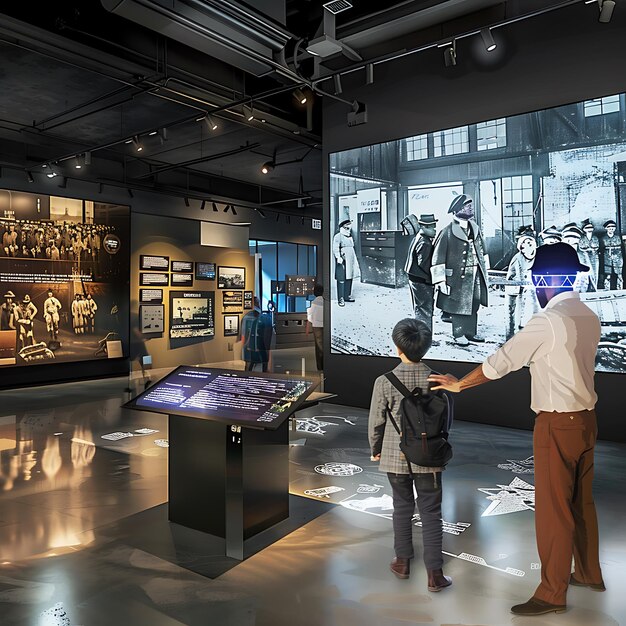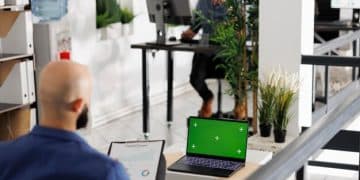The Future of Retail: Thrive in E-Commerce Era

Navigating the competitive retail landscape, traditional brick-and-mortar stores can thrive by adopting innovative strategies that integrate technology, enhance in-store experiences, and leverage their unique physical presence to complement the rise of e-commerce, ensuring continued relevance and customer engagement.
The retail sector is currently experiencing a significant transformation, driven by technological advancements, evolving consumer behaviors, and the rapid growth of online shopping. While e-commerce continues its upward trajectory, questions persist about the long-term viability of physical stores. This article explores The Future of Retail: How Brick-and-Mortar Stores Can Thrive in the Age of E-Commerce by adapting, innovating, and leveraging their inherent advantages.
Redefining the In-Store Experience
The shift in consumer preferences demands more than mere transactions from physical stores. Today, brick-and-mortar retail isn’t just about selling products; it’s about curating memorable experiences that resonate deeply with customers. This evolution is crucial for survival and allows stores to distinguish themselves from the convenience of online shopping.
Experiential Retail: Beyond Transactions
Creating an immersive environment transforms shopping into an event, making it a destination rather than just a point of purchase. Retailers are investing in creative concepts that engage all senses, fostering emotional connections with their brands.
- Interactive Displays: Utilizing touchscreens, augmented reality (AR) mirrors, and virtual reality (VR) headsets to allow customers to visualize products in different settings or personalize items.
- Workshops and Classes: Offering hands-on experiences related to products, such as cooking classes at a kitchenware store or design workshops at a furniture outlet.
- Cafes and Lounges: Integrating food and beverage services to encourage longer stays and create a more relaxed, communal atmosphere.
- Personalized Consultations: Providing one-on-one sessions with experts to offer tailored advice and product recommendations, enhancing the feeling of VIP service.
Seamless Omnichannel Integration
The modern consumer expects a fluid experience across all touchpoints, whether online or offline. This means physical stores must be intricately linked with their digital counterparts to provide a cohesive journey.
Omnichannel integration is not just about having an online store and a physical one; it’s about making them work in harmony. This includes features like “buy online, pick up in-store” (BOPIS), “return in-store,” and access to online inventory within the physical store. The goal is to eliminate friction and provide convenience, catering to varied shopping preferences. It also includes using data gathered from online interactions to personalize the in-store experience, ensuring that every touchpoint adds value. Retailers are increasingly using technologies such as beacons and Wi-Fi tracking to understand customer behavior in-store, further closing the gap between the digital and physical realms. This data-driven approach allows for dynamic store layouts, optimized staffing, and personalized promotions delivered in real-time to a customer’s device while they are browsing in an aisle.
Ultimately, by focusing on redefining the in-store experience, brick-and-mortar stores can transform themselves from mere points of sale into vibrant hubs of community, discovery, and personalized service, ensuring their enduring appeal in a digitally dominated world.
Leveraging Technology for Enhanced Operations
Beyond improving the customer experience, technology plays a critical role in optimizing the operational efficiency of brick-and-mortar stores. Smart application of technology can streamline processes, reduce costs, and provide invaluable insights into consumer behavior, allowing retailers to make data-driven decisions that propel them forward.
Smart Inventory Management
Efficient inventory management is the backbone of successful retail. Technology provides the tools to move beyond traditional manual systems, offering real-time visibility and predictive capabilities.
- RFID Tagging: Enables quick and accurate tracking of products from warehouse to sales floor, reducing instances of out-of-stocks and overstocking.
- AI-Powered Forecasting: Utilizes machine learning to analyze past sales data, current trends, and external factors (like weather or social media buzz) to predict future demand with higher accuracy, optimizing stock levels.
Personalized Customer Engagement
Technology allows retailers to offer highly personalized experiences, bridging the gap between mass marketing and individual preferences. This level of customization fosters stronger customer loyalty and drives repeat business.
Using in-store analytics, retailers can identify repeat shoppers and tailor offers based on their purchase history. Mobile apps can also integrate loyalty programs, allowing customers to track points, receive exclusive discounts, and even interact with store associates for personalized assistance. Proximity marketing, using technologies like Bluetooth beacons, can send targeted promotions to customers’ phones as they browse specific departments, enhancing the shopping experience by making it more relevant to their immediate needs and interests. The ability to push contextually relevant information, whether it’s product details, reviews, or special pricing, right into the hands of the customer while they are in front of the product, is a powerful tool.
Furthermore, integrating customer relationship management (CRM) systems with point-of-sale (POS) systems allows store associates to access a customer’s complete purchase history and preferences, enabling them to offer truly personalized recommendations and service. This data-driven approach ensures that interactions are meaningful and value-driven, solidifying the customer-store relationship far beyond a single transaction.

The Power of Physicality: Unique Advantages
In an age dominated by digital interactions, the very physicality of brick-and-mortar stores offers distinct advantages that e-commerce simply cannot replicate. These unique attributes are critical differentiators, providing compelling reasons for consumers to step away from their screens and into a retail space.
Sensory Engagement and Product Interaction
Shopping in a physical store is a multi-sensory experience that online platforms cannot fully replicate. The ability to see, touch, smell, and even taste a product before purchase significantly enhances the customer’s confidence and satisfaction.
Consider a clothing store where customers can feel the texture of fabrics, try on garments to assess fit and style, and see how colors truly appear under different lighting. In a specialty food store, customers might sample cheeses or smell fresh-baked bread. Electronics stores offer the chance to hold and operate devices, comparing their tactile qualities and user interfaces firsthand. These tangible interactions reduce purchase hesitation and often lead to higher customer satisfaction, as expectations are set more accurately. Unlike the flat, two-dimensional images and descriptions online, the physical store provides a comprehensive, three-dimensional understanding of a product, making the decision-making process more robust and enjoyable.
Immediate Gratification and Personal Service
The instantaneity of physical retail is a powerful draw. Customers can purchase an item and take it home immediately, bypassing shipping delays and costs. This immediate gratification is a key advantage over even the fastest delivery services.
Beyond instant product acquisition, physical stores provide an unparalleled level of personal service. Knowledgeable sales associates can offer expert advice, answer questions in real-time, and provide styling tips or product demonstrations. This human interaction builds trust and rapport, creating a social aspect to shopping that many consumers value. For complex purchases or items requiring detailed explanation, the presence of a human expert can be invaluable, guiding customers through options and ensuring they make the right choice for their needs. This personalized attention not only enhances the shopping experience but also fosters loyalty, as customers feel genuinely cared for and understood.
The unique advantages inherent in the physical retail environment—sensory engagement, immediate gratification, and personalized human service—are powerful tools that, when effectively leveraged, allow brick-and-mortar stores to not only compete but thrive in the e-commerce era. These elements create a distinctive value proposition that digital platforms cannot fully replicate.
Fostering Community and Experience Hubs
Traditional retail spaces are evolving beyond mere transactional points to become vibrant community hubs and experiential centers. This transformation is pivotal for brick-and-mortar stores to maintain relevance and attract foot traffic in an increasingly digital world. By offering more than just products, they can create compelling reasons for people to visit.
Retail as a Social Destination
The desire for social connection remains a fundamental human need. Physical stores can tap into this by designing spaces that encourage lingering, interaction, and discovery, turning shopping into a social outing.
This can involve integrating cafes, reading nooks, or even art installations within the retail environment. Consider book stores with cozy reading areas and coffee shops, or clothing brands that host fashion shows and pop-up events. These elements transform a functional errand into an enjoyable leisure activity. Stores can also become venues for local events, such as book signings, live music, or workshops, attracting people who might not otherwise visit. By becoming a place where people can meet, relax, and be entertained, stores foster a sense of community and brand affinity that extends beyond product offerings. This approach leverages the psychological aspect of shopping—it’s not just about what you buy, but how you feel and what you experience during the process.
Partnerships and Pop-Ups
Collaboration with other brands and hosting temporary retail experiences (pop-ups) are effective strategies for creating novelty and drawing new audiences. These initiatives keep the retail environment fresh and exciting.
By partnering with complementary businesses, retailers can cross-promote their offerings and appeal to a broader customer base. For example, a sports apparel store might collaborate with a local fitness studio to offer classes on-site, or a home goods store could partner with an interior design firm for consultation sessions. Pop-up shops, whether featuring emerging local artisans or established brands offering limited editions, generate buzz and a sense of urgency. These temporary installations allow stores to experiment with new concepts, test market demand for specific products, and create a dynamic retail landscape that encourages repeat visits. The ephemeral nature of pop-ups creates a “fear of missing out” (FOMO) that drives traffic and immediate sales, while also giving customers a unique, time-sensitive reason to visit the physical location.
Transforming into community and experience hubs allows brick-and-mortar stores to offer unique value propositions that e-commerce cannot replicate. They become places where people connect, learn, and are entertained, solidifying their role as essential components of the modern consumer landscape. This shift from transaction to interaction is key to thriving in the future of retail.
Embracing Sustainability and Ethical Practices
In an era of increasing consumer awareness and environmental concerns, embracing sustainability and ethical practices is no longer a niche consideration for brick-and-mortar stores; it’s a fundamental imperative. Consumers, particularly younger generations, are making purchasing decisions based on a brand’s commitment to social and environmental responsibility. Integrating these principles into the core operations and messaging of physical retail can build trust, enhance brand loyalty, and attract a conscious customer base.
Eco-Friendly Store Design and Operations
Sustainable practices can be woven into the very fabric of the physical store, from its construction to its daily operations. This visible commitment signals a brand’s values to its customers.
Designing stores with locally sourced, recycled, or rapidly renewable materials not only reduces environmental impact but also creates a unique aesthetic. Implementing energy-efficient lighting (like LED systems), optimizing HVAC systems, and utilizing renewable energy sources (such as solar panels where feasible) can significantly lower a store’s carbon footprint. Furthermore, focusing on waste reduction through robust recycling programs, composting organic waste, and minimizing single-use plastics demonstrates a genuine commitment to sustainability. Even small changes, like offering reusable shopping bags or providing water refill stations, contribute to a positive environmental image and resonate with eco-conscious consumers. These operational choices are becoming increasingly important for communicating a brand’s ethos.
Transparent Sourcing and Community Impact
Consumers want to know where their products come from and how they are made. Brick-and-mortar stores have a unique opportunity to educate customers and highlight their transparent and ethical sourcing practices.
By showcasing information about their supply chain, from the origins of raw materials to the labor practices involved in production, retailers can build profound trust. This might include displaying certifications for fair trade, organic, or sustainably harvested materials. Partnering with local artisans and suppliers not only supports the local economy but also reduces transportation-related emissions, creating a compelling narrative for consumers. Sharing stories about the positive impact a brand has on its community or on the lives of its producers adds a human element that online-only retailers often struggle to convey. Promoting products with a clear social mission, donating a portion of sales to charity, or organizing community clean-up events further entrenches a store’s role as a responsible corporate citizen. These initiatives transform the retail space into a platform for positive change, appealing to values-driven consumers who seek to align their purchases with their personal ethics.
By prioritizing sustainability and ethical practices, brick-and-mortar stores can differentiate themselves substantially. They move beyond being just places to buy goods, becoming destinations that align with customer values, fostering deeper loyalty and ensuring long-term relevance in a market that increasingly rewards responsible commerce.
Adapting Staff Roles and Training
The evolution of brick-and-mortar retail necessitates a fundamental shift in the roles and training of store staff. No longer are employees simply cashiers or stockers; they are becoming brand ambassadors, technology enablers, and experience facilitators. Empowering staff with new skills and responsibilities is crucial for creating the dynamic and engaging in-store environment that modern consumers expect.
From Sales Associate to Brand Ambassador
The traditional sales associate role is expanding to encompass a broader spectrum of responsibilities focused on creating a holistic brand experience. Staff are now key representatives of the brand’s values and mission.
This transformation requires training in product knowledge, but also in storytelling and relationship building. Staff should be able to articulate the brand’s narrative, explain product origins, and share its sustainability efforts. They need to be adept at personalized service, remembering customer preferences, and anticipating needs. This goes beyond transactional selling; it’s about fostering emotional connections and building loyalty. For instance, a staff member might not just sell a pair of shoes but also discuss the artisan who crafted them, the ethical sourcing of materials, and how to style them for different occasions. This deeper engagement transforms a mere purchase into a valuable interaction, reinforcing the brand’s identity and enhancing the customer’s perception of value.
Integrating Technology and Data Literacy
As stores become more technologically advanced, staff must be proficient in using these tools to enhance both operations and customer interactions. This includes understanding and leveraging data insights.
Training should cover in-store technologies such as mobile POS systems, inventory management software, and customer relationship management (CRM) tools. Staff need to be comfortable using tablets to check stock availability across multiple locations, place online orders for customers, or even assist with virtual try-ons using AR. Furthermore, basic data literacy is becoming essential. Staff should be able to interpret customer data to personalize recommendations, understand foot traffic patterns, and optimize product placement. This level of technological integration streamlines processes, improves efficiency, and allows staff to spend more time engaging with customers rather than on administrative tasks. Ongoing training programs must be in place to ensure staff can adapt to new technologies as they emerge, maintaining a competitive edge in a rapidly evolving retail landscape.
The investment in staff training and development is an investment in the future of brick-and-mortar retail. By transforming employees into knowledgeable brand ambassadors and tech-savvy facilitators, stores can deliver an elevated, personalized, and efficient experience that perfectly complements the digital shopping journey, reinforcing their unique value proposition.
Future-Proofing Through Agility and Innovation
The retail landscape is in a constant state of flux, driven by rapid technological advancements and shifting consumer expectations. For brick-and-mortar stores to thrive in this environment, adopting a mindset of agility and continuous innovation is not merely beneficial—it’s essential for long-term survival and growth. This means being responsive to change, willing to experiment, and committed to evolving the retail model.
Embracing Data-Driven Decision Making
In the modern retail ecosystem, data is king. The ability to collect, analyze, and act upon insights from various data streams empowers retailers to make informed choices that optimize operations, enhance customer experience, and drive sales.
Leveraging analytics tools to understand foot traffic patterns, sales performance by product and time, customer demographics, and even sentiment analysis from social media can provide a comprehensive view of what is working and what isn’t. Predictive analytics can help anticipate trends, optimize inventory, and personalize marketing campaigns. For instance, data might reveal that a particular product sells better during specific hours, allowing for better staffing during those times. Or, analysis of customer loyalty program data could inform targeted promotions that resonate with individual preferences. This data-first approach moves decision-making from intuition to evidence, significantly reducing risk and increasing the potential for success. Retailers should invest in robust data infrastructure and cultivate a culture where data literacy is valued across all levels of the organization.
Experimentation and Flexibility
The future of retail is not a fixed destination but an ongoing journey of adaptation. Stores must be willing to experiment with new formats, technologies, and business models, and maintain the flexibility to pivot quickly based on feedback and market response.
This includes piloting new store layouts, testing interactive technologies like smart mirrors or AR apps, or trying out unique experiential concepts. Pop-up shops are an excellent example of this, allowing retailers to test new markets or product lines without significant long-term commitments. Implementing a “fail fast, learn faster” philosophy encourages innovation and reduces the fear of failure. It means being open to feedback from customers and employees, agilely adjusting strategies, and not being afraid to discard ideas that don’t land well. Retailers should establish internal processes that facilitate rapid prototyping and deployment of new initiatives, fostering an environment where creativity and continuous improvement are prioritized. This culture of experimentation ensures that brick-and-mortar stores remain dynamic, relevant, and capable of adapting to whatever the future holds, transforming challenges into opportunities for growth.
| Key Point | Brief Description |
|---|---|
| 🛍️ Experiential Retail | Physical stores must become destinations that offer unique and immersive experiences, not just products. |
| 📲 Tech Integration | Leverage technology for efficient operations, personalized engagement, and seamless omnichannel experiences. |
| 🤝 Community Hubs | Transform spaces into social destinations hosting events, workshops, or partnerships to foster community. |
| 🌱 Ethical Practices | Embrace sustainability and transparent sourcing to build trust and appeal to value-driven consumers. |
Frequently Asked Questions About the Future of Retail
The primary challenge is competing solely on price and convenience. E-commerce often offers lower prices and doorstep delivery. Physical stores must differentiate by offering unique, engaging experiences, personalized service, and immediate gratification that online channels cannot replicate.
Technology enhances efficiency through smart inventory management, offers personalized customer engagement with AI and mobile apps, and facilitates seamless omnichannel integration like BOPIS. It also provides valuable data insights for better decision-making and operational optimization.
Experiential retail turns shopping into an event, making the store a destination. It allows customers to engage with products multi-sensorially, participate in workshops, or enjoy cafes, fostering emotional connections and memorable interactions that transcend simple transactions.
Absolutely. Consumers increasingly value sustainability and ethical sourcing. Integrating eco-friendly store designs, transparent supply chains, and community impact initiatives builds trust, enhances brand loyalty, and appeals to a growing segment of conscious consumers.
Employees are transforming from sales associates into brand ambassadors. They require training in product knowledge, technology literacy, and personalized service. Their ability to deliver unique, human-centric interactions is crucial for creating valued in-store experiences.
Conclusion
The narrative of traditional retail’s demise in the face of e-commerce is largely overstated. While challenges abound, brick-and-mortar stores possess inherent advantages that, when strategically leveraged, position them for enduring success. By redefining the in-store experience to be immersive and experiential, integrating advanced technology for seamless operations and personalized engagement, and embracing their unique physical attributes for sensory interaction and immediate gratification, physical retail can offer what online cannot. Furthermore, fostering community hubs, prioritizing sustainability, and transforming staff into knowledgeable brand ambassadors will ensure their continued relevance. The future of retail is not about choosing between physical and digital, but about blending them to create a synergistic, customer-centric ecosystem where brick-and-mortar stores thrive as dynamic destinations of discovery, community, and unparalleled human connection.





